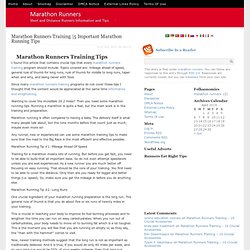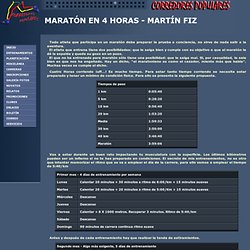

Página web de running popular con información sobre entrenamiento, material, calendario de carreras, nutrición, lesiones, trail. La mayor web de carreras para atletas y empresas. 5 Important Marathon Running Tips. June 3rd, 2011 by admin I found this article that contains crucial tips that every marathon runners training program should include.

Topics covered are: mileage ahead of speed, general rule of thumb for long runs, rule of thumb for middle to long runs, taper when and why, and being clever with food. Since many marathon runners training programs do not cover these tips I thought that the content would be appreciated at the same time informative and enlightening. Wanting to cover the incredible 26.2 miles? Then you need some marathon running tips. Marathon running is often compared to having a baby. Any runner, new or experienced can use some marathon training tips to make sure that the road to the Big Race is the most efficient and effective possible. Marathon Running Tip #1: Mileage Ahead Of Speed Training for a marathon means lots of running.
Marathon Running Tip #2: Long Runs One crucial ingredient of your marathon running preparation is the long run. Marathon Running Tip #4: Taper. Rules of Thumb for Running a Marathon (Marathoning Matters) Race pace.

Training pace. Calories per mile. How much hot days slow you down. Over the years I've learned a number of rules of thumb about running marathons, covering everything from the impact of weight on performance to how running marathons impacts age and how age impacts running marathons. What follows are the rules of thumb that seem to matter most and ring most true. Taper and Race Day Rules of Thumb Taper your training so that you run no more than 85, 75, and 50 percent of your maximum mileage the three weeks before the marathon, respectivelyNever try anything during a marathon that you haven't tried in practice runs (eating Gu, drinking a sports drink, wearing different socks, shoes or shirts, etc.)Drink about 4 ounces of fluid per mile. La mejor estrategia para el maratón.
Muchos principiantes en maratón piensan que si han hecho una media en dos horas, lo tendrían bien fácil para acabar el maratón en cuatro.

Y lo malo es que como consecuencia de este error se equivocan en los planes de entrenamiento y con el ritmo de carrera. Lo peor es que es una persona que hace la media en dos horas, y que podría correr el maratón perfectamente en 4:30 acaba llegando reventado en 5 horas por forzar. Para centrarte un poco aquí tienes una tabla que partiendo, por ejemplo de la marca que hayas hecho en los 10 km de la San Silvestre, te ayude a intuir cuál puede ser un objetivo realista en el maratón. Nada hace tanto daño a un entrenamiento para maratón que tener que parar dos o tres semanas por una periostitis o por otra lesión.
Por ello, hay que tomar todas las medidas antilesión posibles: - Evita correr por asfalto. - Estira todos los días después de entrenar durante al menos cinco minutos. . - No hagas locuras con los rodajes largos. . - Respeta los días de descanso. Circuito Trail Valencia. Correr, una forma de vivir. Carreraspopulares.com Calendario Nacional de Carreras Populares. LlegaRunning. PLAN-ENTRENAMIENTO-SUB-4-h2. Entrenamiento maratón por Martín Fiz. Todo atleta que participa en un maratón debe preparar la prueba a conciencia, no sirve de nada salir a la aventura.

El atleta que entrena tiene dos posibilidades: que le salga bien y cumpla con su objetivo o que el maratón le dé la espalda y quede su gozo en un pozo. El que no ha entrenado para maratón sólo tiene una posibilidad: que le salga mal. Si, por casualidad, le sale bien es que nos ha engañado. Hay un dicho, “el maratoniano es como el cazador, miente más que habla”. Muchas veces se cumple el dicho. Cuatro Horas corriendo ¡uff...! Vas a estar durante un buen rato impactando tu musculatura con la superficie. Antes y después de cada entrenamiento hay que realizar la tanda de estiramientos. Los domingos hay que aprovechar para realizar salidas largas. Ni que decir que los últimos diez días hay que ir bajando la cantidad de entrenamientos.